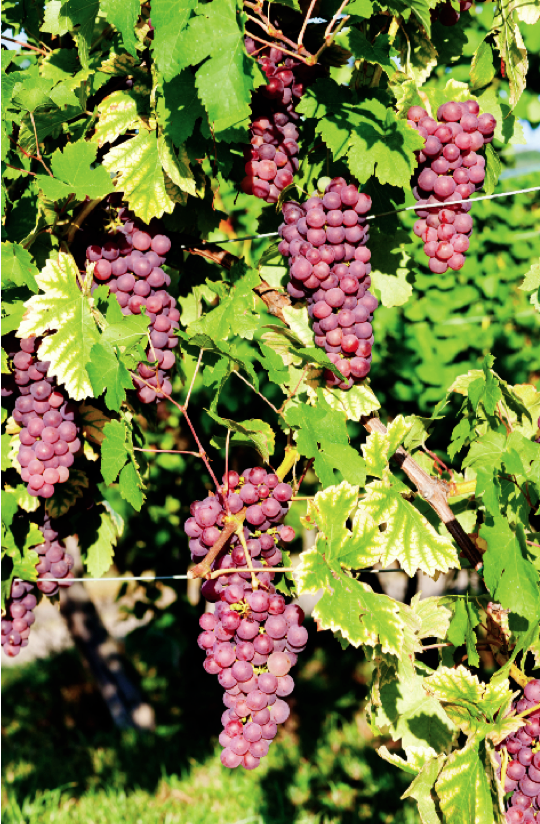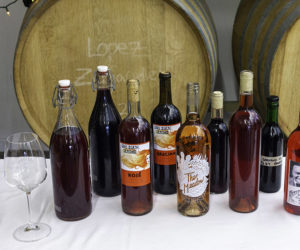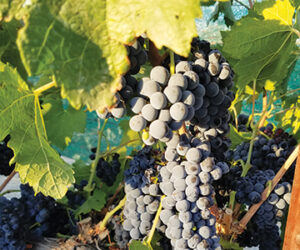 Gewürztraminer: The name says it all. German? Sure why not, it sounds German, even looks German with the two little dots above the ‘u’, which is known as the umlaut. However, to the French, it is pronounced the same, but is not written with the umlaut. Looking at a current map, the department of Alsace, where Gewürztraminer is commonly grown, is on the French side of the border of the Rhine River. This region of the world has been in dispute between France and Germany throughout history, however. France just happens to hold the trump card in today’s modern Europe.
Gewürztraminer: The name says it all. German? Sure why not, it sounds German, even looks German with the two little dots above the ‘u’, which is known as the umlaut. However, to the French, it is pronounced the same, but is not written with the umlaut. Looking at a current map, the department of Alsace, where Gewürztraminer is commonly grown, is on the French side of the border of the Rhine River. This region of the world has been in dispute between France and Germany throughout history, however. France just happens to hold the trump card in today’s modern Europe.
Alsace, and its neighboring department Lorraine, were part of the Holy Roman Empire until 1766 when the region became a part of France. Just over a hundred years later, in 1871, Alsace and part of Lorraine were annexed by Germany as a result of a dispute between Bismarck of Germany and Napolean III. Following World War I, Alsace was returned to France, only to have it flip back to Germany in 1939 at the beginning of World War II. After World War II, the department was returned to French rule, where it stands in today’s modern Europe.
French and Germanic heritage aside, the region is semi-autonomous with its own language, Alsatian, a special dialect that is reserved for the locals. Typically French or German is spoken with outsiders, and there are unwritten rules as to when and where Alsatian is spoken, presumably to protect the secret autonomy of the region. With Gewürztraminer, it is rich in history and tradition.
Early on in Alsace, the wines of Alsace were traded alongside the wines of Germany, notably Rieslings and the red Spätburgunder (Pinot Noir to the non-German). The trade was facilitated due to the proximity to either side of the Rhine River. Stylistically, the wines were very similar. After World War II, the styles diverged with the Alsatian wines becoming drier than their German counterparts. However in the last twenty years or so, with such globalization of the wine trade, each region yields both sweet and dry versions in an effort to be competitive on all fronts. Alsace was granted Appellation d’Origine Contrôlée (AOC) status in 1962, and AOC Grand Cru in 1975. It is the only AOC in France that allows the varietal name on the label, hanging on to some of its Germanic roots, where varieties are commonly listed on the label. Alsace also has a late harvest wine classification, Vendange Tardive (VT) and Sélection de Grains Nobles (SGN), in which Gewürztraminer, respectively is made in the styles and classification of the German Auslese or Beerenauslese styles. The latter reference to wines made with select barriers infected with Botrytis, or noble rot. The wines of Alsace are also bottled in the historic flute d’Alsace. You would recognize these bottles for their tall thin appearance; they have also been referred to as the “Rhine wine bottle.” You will see many German wines bottled in this style as well.
Alsace vineyards are tucked into the predominantly east facing slopes of the Vosges Mountains, between the mountains themselves and the Rhine River. The mountains form a rain shadow from the prevailing winds keeping the rainfall in the region relatively low at about 20 inches annually. The total area of vineyard has increased since 1967, when there were 23,000 acres to about 40,000 acres today. Gewürztraminer plantings account for about 20% of that area, sharing 90% of the white wine production in the region with Pinot Gris, Sylvaner, Müller-Thurgau, Muscat and Riesling.
I never met Dr. Maynard Amerine, one of the founders of the Department of Viticulture and Enology at the University of California-Davis, but I have heard that one of his statements about making great Gewürztraminer wines is that you have to sleep in the vineyard. I never understood what this meant until I actually had the opportunity to make wine from this grape when I came to the university in 2006. At the time, we had a demonstration plot, appropriately called the demonstration block, or demo block, and in it were fifty individual short rows of various grapes, fourteen vines total in each row. Many of these varieties were not suited for the hot climate in Davis, and usually wound up sunburned or severely raisined, but for some reason the Gewürztraminer always held out. As the story goes, the first year I made it, as I walked the vineyard making picking decisions, I liked the spice flavor coming up at about 19 °Brix, but held off picking as it just didn’t seem right to pick when the Brix was so low. I was still cutting my teeth with the “ABC” (Anything but Chardonnay/Cabernet) varieties, and I was thinking how low the alcohol would be and that the wine would not be balanced. Alas, I waited until the magic Brix of 24 and then picked. The wine was good, exhibited some typical flavor profiles, but just didn’t seem complete. It was then that a friend told me what Dr. Amerine had said and it all clicked.
Gewürztraminer is classified as a white grape, however it has pink to red skin tones (see the photo on page 21). None of these pigments translate into the wine, even with some incidental skin contact. The variety has a characteristic spice tone for which the “Gewürz” in its name refers to. The grape is rich in terpenes, which when not bound to sugars in solution, play an important role in the spicy varietal character for which the wine is known for. Incidentally, terpenes are also responsible for the varietal character you would find in Muscat grapes as well. Terpenes in wine can be both free and bound. The term “bound” refers to the chemical bonding that takes place between the terpene and a mono- or di-saccharide sugar moiety, such as glucose (mono-) or arabinose, rhamnose or apiose, (di-). Bound terpenes are non-volatile, thus not contributing to the aroma profile.
However, these bound forms are flavor precursors and the aroma profile of the wine is largely due to the free forms of the terpenes in solution. Some winemakers choose to add enzymes to terpene rich wines toward the end of fermentation. These enzymes cleave the sugar moiety, releasing the free form, which can contribute to enhanced varietal character. It is important to use the correct enzyme, as they all have a specific function. Local winemaking shops should be able to help you decide which enzyme is best for you. I do not personally go this route, but have done so in the past with mixed results. The challenge of working with enzymes in winemaking is that the pH and the temperature of the wine must be just right to get the most effect. This is because the enzyme is a protein whose function is governed by temperature, and stability is affected by pH with lower pH being the most detrimental.
It is the terpenes and the aromatic nature of this spicy variety that contributed to a research project undertaken at the University of California-Davis in 2007. The relationship between glass shape and chemical composition of the glass headspace and the relationship between glass shape and sensory characteristics was studied. As we were looking for the right wine to use for this study, the graduate student discovered my 2006 Gewürztraminer, the one I had deemed not so great. While there was the spice character I had mentioned, he was interested mostly in the terpenes he found when he had analyzed the wine by gas chromatography. The gas chromatograph is a very complex laboratory instrument that “dissects” the wine volatiles at a molecular level. It sort of takes the fun out of tasting the wine mostly from the perspective that no one could possibly detect all the compounds it finds, making you feel a little inadequate with regard to your own sensory skills. Nevertheless, it was important information for the study. The study concluded that when the wine was poured into a variety of glasses, it varied in its headspace composition and sensory profile. Although no glass shape parameters were found to correlate with descriptor intensities, it was clear that the shape of the glass did have an effect on both the headspace volatile composition and the aroma profile of the wine. The moral of the story is, if you are just not getting what you want out of the wine, and you are using a small glass, seek out glasses with a larger bowl that you can sink your nose into. Not just with Gewürztraminer, but any wine.
Gewürztraminer is a fairly unique variety with not a lot of examples originating from other parts of the world other than the Alsace region. Ironically, given its Germanic heritage, very little is grown in Germany proper, unless of course the border is re-arranged again in the future. Australia boasts some examples, however it is the only country in the southern hemisphere to do so. It is produced in North America in Canada’s Okanagan Valley in the west, and to the east in the Niagara Peninsula. New York’s Finger Lakes area also produces some fine examples, which many of those who attended the 2012 WineMaker Magazine Conference got to taste. On the west coast of the US it is grown in the cooler regions of the central and north coasts of California as well as into Oregon and Washington. Interestingly, one producer in the Anderson Valley of California makes a sparkling example that I think is just delicious. My first experience with Gewürztraminer, however, was in Oregon’s Willamette Valley where I assumed it would be made into a slightly sweet example, but the winemaker surprised me with a dry version. That was more than twenty years ago, but I still remember the moment.
Given its acidity, styles range from slightly sweet to dry. The German style is generally slightly sweet with low alcohol to counteract the acidity. The Alsatian styles are usually dry. They can be chaptalized in some years, but are still dry in every respect. Whatever the style, the wine can be paired with traditional Alsatian foods such as the thin-crusted pizza-like Flammkuchen (which translated means “flame cake” and is also known as Tarte flambée), sauerkraut, Bäckeoffe — a slow-cooked meal made with pork, lamb, beef and sliced potatoes, and cheeses such as Munster. Non-traditionally, the sweeter styles of Gewürztraminer tame the spiciness of Asian foods. Ironically, I contacted a colleague of mine in Alsace about the wines and their food pairing and this is what she wrote back to me: “Concerning the Gewürztraminer, everyone says Thai food but we tend to use it as an aperitif at weddings/ dinners, exotic fruit desserts and even more so with strong cheeses like Munster (now that’s a perfect pairing). Nothing fits spicy food like a good, crisp Riesling.” So there you have it, spoken like a true local. Actually she’s an ex-pat who has been in Alsace for many years and her winery produces excellent examples of both Gewürztraminer and Riesling.
Of all the varieties we cover in this column, I feel that this is one of mixed identity. Sure Burgundy has Pinot Noir, the Loire has its Chenin Blanc, but those are varieties that are easily identified with a country. Alsace and the unique nature of its history acts like a country, but is a region whose identity leans Germanic but at the present time belongs to France. The wines from this region have been produced under sometimes tumultuous circumstances. The people of Alsace are proud of the heritage and in this case, have a grape variety that they can call their own.
Gewürztraminer Recipe
(yield: 5 gal/19 L)
Ingredients
• 100 lbs. (45 kg) Gewürztraminer fruit or 5 gallons (19 L) commercially available juice (clarified)
• Distilled water
• 10 % potassium metabisulfite (KMBS) solution: Weigh 10 grams of KMBS, dissolve into about 75 milliliters (mL) of distilled water. When completely dissolved, make up to 100 mL total with distilled water.
• 5 grams Lallemand QA23 yeast (Premier Cuvée can be a substitute)
• 5 grams Fermaid K (or similar)
• 5 grams Di-ammonium Phosphate (DAP)
• Freeze-dried malolactic bacteria (ChrHansen) (optional)
Other equipment or needs specific to this recipe
•5-gallon (19-L) carboy
•6-gallon (23-L) carboy
•6-gallon (23-L) plastic bucket
•Airlock/stopper
•Racking hoses
•Equipment cleaning and sanitizing agents (Bio-Clean, Bio-San)
•Inert gas (nitrogen, argon or carbon dioxide will do)
•Refrigerator (~45 °F/7 °C) to cold settle the juice. (Remove the shelves so that the bucket will fit.)
•Ability to maintain a fermentation temperature of 55 °F (13 °C) TIP: Use a 33-gallon (125-L) plastic can as a water bath. Place ice blocks in the water to maintain a relatively constant temperature. This will be your refrigeration system for peakvfermentation. If you have other means to keep things cool, of course use that.
•Thermometer capable of measuring between 40–110 °F (4–43 °C) in one degree increments
•Pipettes with the ability to add in increments of 1 milliliter
•A means to measure residual sugar at the completion of fermentation
•Ability to test or have testing performed for sulfur dioxide
Step by Step
1. Clean and sanitize all of your winemaking tools and equipment.
2. Crush and press the grapes (if working with fresh fruit). Do not delay between crushing and pressing. Avoid extended contact with skins and seeds.
3. Transfer the juice to a 6-gallonn(23-L) bucket and add 16 milliliters of 10% KMBS solution. (This addition is the equivalent of 40 mg/L (ppm) SO2). Move the juice to the refrigerator.
4. Let the juice settle at least overnight. Layer the headspace with inert gas and keep covered.
5. Measure the Brix and acidity. Adjust the acidity to 6.0–7.0 g/L. (If the acidity is greater than 7.0 g/L, consider the option of inoculating for the malolactic fermentation and the completion of the alcoholic fermentation (described later in this recipe).
6. When sufficiently settled, rack the juice off of the solids into the 6-gallon (23-L) carboy.
7. Prepare yeast. Heat about 50 mL distilled water to 108 °F (42 °C). Measure the temperature. Pitch the yeast when the suspension is 104 °F (40 °C). Sprinkle the yeast on the surface and gently mix so that no clumps exist. Let sit for 15 minutes undisturbed. Measure the temperature of the yeast suspension. Measure the temperature of the juice. You do not want to add the yeast to your cool juice if the temperature of the yeast and the must temperature difference exceeds 15 °F (8 °C). To avoid temperature shock, acclimate your yeast by taking about 10 mL of the juice and adding it to the yeast suspension. Wait 15 minutes and measure the temperature again. Repeat these steps until you are within the specified temperature range. Do not let the yeast sit in the original water suspension for longer than 20 minutes. When the yeast is ready, add it to the fermenter.
8. Add the Fermaid K or equivalent yeast nutrient.
9. Initiate the fermentation at room temperature ~(65–68 °F/18–20 °C). Once fermentation starts (~24 hrs.), hold the temperature at 55 °F (13 °C).
10. Two days after fermentation starts, dissolve the DAP in as little distilled water required to completely go into solution (usually ~ 20 mL). Add directly to the carboy.
11. Measure the Brix every 2–3 days to monitor progress. Sanitize anything that will come in contact with the juice. Leave alone until bubbles in the airlock are about one bubble per minute. Usually two to three weeks.
12. Measure the residual sugar. The wine is considered dry, or nearly dry when the Brix reaches -1.5 °Brix or less. When the result is less than 0.5%, raise the temperature to about 65 °F (18 °C) and then inoculate with your malolactic bacteria if you wish.
13. Monitor the progress of the malolactic fermentation using thin layer chromatography.
14. If you do not inoculate for MLF, add 3 mL of fresh KMBS (10%) solution per gallon of wine, or when the MLF is complete, add 3 mL of fresh KMBS (10%) solution per gallon of wine. This is the equivalent to ~40 ppm addition. Transfer the wine to the 5-gallon (19-L) carboy and lower the temperature to 38-40 °F (3–4 °C).
15. After two weeks, test for pH and SO2 adjusting as necessary to attain 0.8 ppm molecular SO2. (Use the SO2 calculator on the Web at www.winemakermag.com/guide/sulfite).
16. Check the SO2 in another two weeks, prior to the next racking and adjust while racking. This is done at about 4–6 weeks after the first SO2 addition. Once the free SO2 is adjusted, maintain at the target level by monitoring every 3–4 weeks.
17. Consult winemakermag.com for tips on fining and filtration if you feel it is necessary.
18. After about three months you are ready to move the wine into bottles. Be sure to always maintain sanitary conditions while bottling. Once your wine is bottled, you’ll need to periodically check your work by opening a bottle every few months to taste and enjoy with friends.






